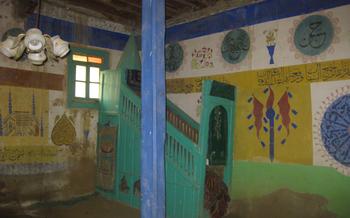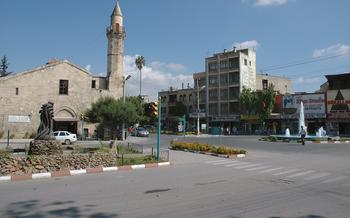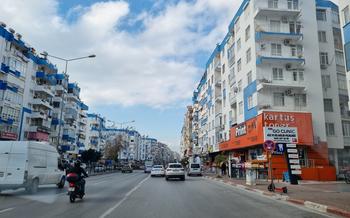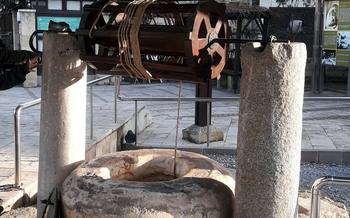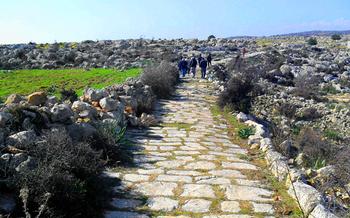
St. Paul Trail
- St. Paul Trail: A Journey Through History and Faith
- Pilgrimage Experience
- Cultural Interactions
- Outdoor Activities
- Historical Sites
- Planning Your Trip
- Best Time to Visit
- Accommodation
- Transportation
- Trail Routes
- Insider Tip
- Safety and Precautions
- Accommodation Options
- Food and Provisions
- Cultural Experiences
- Budget Planning
- Sustainable Travel
- Insider Tip: Uncover Hidden Gems and Capture the Essence of the Trail
St. Paul Trail: A Journey Through History and Faith
Historical Significance
The St. Paul Trail in Isparta, Turkey, offers a unique opportunity to trace the footsteps of the Apostle Paul during his missionary journey through the region. As you embark on this historic trail, you will be transported back in time to the early days of Christianity, discovering ancient ruins, exploring archaeological sites, and uncovering the rich cultural heritage of the area.
St. Paul's journey through Isparta was a pivotal moment in the spread of Christianity in the region. His teachings and interactions with local communities left a lasting impact, shaping the religious landscape of the area. Along the trail, you will encounter numerous churches, monasteries, and other sacred places associated with St. Paul, providing a tangible connection to the past.
The St. Paul Trail is not only a pilgrimage route but also a testament to the enduring legacy of ancient civilizations. Explore the ruins of Antioch in Pisidia, where St. Paul delivered powerful sermons, or marvel at the grandeur of the Roman amphitheater in Sagalassos, a symbol of the region's rich history. Byzantine churches with intricate architecture and well-preserved mosaics offer a glimpse into the artistry and devotion of past generations.
As you journey along the trail, you will not only discover historical landmarks but also gain a deeper understanding of the cultural and religious heritage of Isparta. Engage with local communities, learn about their traditions, and savor the flavors of traditional Turkish cuisine. The St. Paul Trail is an immersive experience that combines history, faith, and cultural exploration, creating a truly unforgettable journey.
Pilgrimage Experience
The St. Paul Trail is not just a historical or natural wonder; it is also a pilgrimage route of great religious significance. For many Christians, walking the trail is a spiritual journey, a way to deepen their faith and connect with St. Paul's legacy. Along the trail, pilgrims can visit churches, monasteries, and other sacred places associated with St. Paul's missionary work. These sites include the Church of St. Paul in Antioch, where St. Paul preached, and the cave where he is believed to have hidden from his persecutors.
Pilgrims can choose from various routes, depending on their fitness level and interests. The most popular route is the full St. Paul Trail, which covers approximately 500 kilometers and takes about two weeks to complete. However, there are also shorter routes available, ranging from a few days to a week. Pilgrims can walk the trail independently or join organized groups led by experienced guides.
The St. Paul Trail is not just a religious pilgrimage but also a journey of self-discovery and reflection. It is an opportunity to connect with nature, history, and culture and to learn more about oneself and one's faith. Whether you are a devout Christian or simply seeking a unique and meaningful travel experience, the St. Paul Trail is sure to leave a lasting impression.
Cultural Interactions
Immerse yourself in the rich cultural heritage of the region along the St. Paul Trail. Engage with locals to learn about their traditions, customs, and way of life. Savor the delectable flavors of traditional Turkish cuisine, tantalizing your taste buds with regional specialties. Discover the artistry and craftsmanship of local artisans, who create unique handicrafts and souvenirs that reflect the region's cultural identity. Participate in vibrant festivals and cultural events, immersing yourself in the joyous celebrations and lively atmosphere. These interactions offer a glimpse into the heart and soul of the region, providing a deeper understanding of its cultural tapestry.
Outdoor Activities
Lace up your hiking boots and embark on scenic hiking trails that wind through diverse landscapes, offering challenges for all levels of hikers. Pedal through picturesque countryside on two wheels, immersing yourself in the region's natural beauty. Embrace the wilderness by setting up camp under the stars at designated campsites, enjoying the tranquility of nature. Keep your binoculars handy for wildlife watching, as the St. Paul Trail is home to a variety of bird species and other wildlife.
Historical Sites
Ruins of Antioch: Explore the captivating ruins of Antioch in Pisidia, once a thriving city during the Roman era. Marvel at the remnants of ancient structures, including the well-preserved city walls, monumental gates, and the impressive Temple of Men. As you wander through the ruins, imagine the bustling streets and vibrant life that once filled this city.
Roman Amphitheater: Witness the grandeur of the Roman amphitheater in Sagalassos, a testament to the region's rich history. Step into this remarkably well-preserved amphitheater and envision the spectacle of gladiatorial contests and public performances that took place here centuries ago. Admire the intricate carvings and architectural details that adorn the structure, transporting you back in time.
Byzantine Churches: Discover the architectural treasures of Byzantine churches scattered throughout the region. Visit the Church of St. Paul in Isparta, with its impressive dome and intricate frescoes depicting biblical scenes. Admire the Church of Panagia in nearby Eğirdir, featuring stunning mosaics and well-preserved wall paintings. These churches offer a glimpse into the rich artistic and religious heritage of the Byzantine era.
Archaeological Museums: Delve deeper into the region's history by visiting local archaeological museums. The Isparta Archaeological Museum houses a fascinating collection of artifacts unearthed from nearby excavations, providing insights into the area's ancient civilizations. Don't miss the Pisidian stele, an inscribed stone tablet that sheds light on the region's history and culture.
Planning Your Trip
When planning your pilgrimage along the St. Paul Trail, careful consideration of various factors is essential to ensure a smooth and enjoyable experience.
Best Time to Visit
The most suitable time to embark on this journey is during the shoulder seasons, which fall between April-May and September-October. During these periods, the weather is generally pleasant, with moderate temperatures and fewer crowds. The summer months (June-August) can be hot and crowded, while the winter months (November-March) can be cold and snowy, making the trail less accessible.
Accommodation
A range of accommodation options is available along the trail, catering to different budgets and preferences. In towns and villages, you can find hotels, guesthouses, and hostels offering comfortable stays. For a more immersive experience, consider staying in local homestays or guesthouses, where you can interact with local families and learn about their way of life. Camping is also an option, with designated campsites available at strategic points along the trail.
Transportation
Reaching the St. Paul Trail is relatively easy, with several transportation options available. Major cities like Antalya and Isparta have airports with domestic and international connections. From these cities, you can take buses or rent a car to reach the trail's starting point. Once on the trail, you can either walk, cycle, or hire a local guide with a vehicle to assist with transportation.
Trail Routes
The St. Paul Trail offers several official routes tailored to different interests and fitness levels. The main route, known as the "Full Trail," covers the entire journey from Perge to Antioch in Pisidia, spanning approximately 500 kilometers. This route is designed for experienced hikers and takes around two to three weeks to complete.
For those seeking a shorter and more manageable experience, there are several shorter routes available. These routes typically focus on specific sections of the trail and can be completed in a few days or a week. Some popular shorter routes include the "Pisidian Plateau Route," which explores the mountainous region of Pisidia, and the "Coastal Route," which follows the Mediterranean coastline.
To plan your journey, it's essential to choose a route that matches your interests, fitness level, and available time. Maps and guidebooks are readily available to help you navigate the trail and learn about the historical and cultural significance of the sites along the way.
Insider Tip
Venture Off the Beaten Path
While exploring the official St. Paul Trail offers a fantastic experience, don't miss the opportunity to venture off the main trail and discover hidden gems. Numerous lesser-known paths and trails lead to secluded churches, monasteries, and natural wonders.
One such hidden gem is the abandoned Byzantine church of St. George, located a short walk from the village of Kızılca. This beautifully preserved church features intricate frescoes and offers a glimpse into the region's rich history.
Another off-the-beaten-path attraction is the stunning Canyon of the Gods, a natural gorge with towering rock walls and lush vegetation. This hidden gem is perfect for a refreshing swim or a peaceful picnic in the shade of the trees.
Remember, the best way to discover the hidden treasures of the St. Paul Trail is to embrace spontaneity and be open to exploring beyond the main route. You might just stumble upon your own secret spot that offers breathtaking views or a unique and unforgettable experience.
Safety and Precautions
Venturing into the St. Paul Trail requires a conscious approach to safety and precautions. The unpredictable weather conditions demand appropriate clothing and gear to handle sudden changes. Stay hydrated by carrying sufficient water or knowing the locations to refill your bottles. A first-aid kit is essential for minor injuries, and it's advisable to inform someone about your hiking plans and expected return time.
Be aware of potential wildlife encounters and how to respond calmly. Respect local customs and dress modestly to avoid any misunderstandings. Familiarize yourself with the trail's signage and markings to navigate safely.
Accommodation Options
Along the St. Paul Trail, you'll find a range of accommodation options to suit every budget and preference. In nearby towns and villages, you can choose from cozy hotels and guesthouses that offer comfortable stays with modern amenities. For a more immersive experience, consider staying in a traditional Turkish guesthouse or homestay, where you can interact with locals and learn about their way of life.
For those who prefer to embrace the wilderness, camping sites are available at designated locations along the trail. Set up your tent under the stars and enjoy the tranquility of nature. Remember to bring your own camping gear and be prepared for basic amenities.
Budget travelers can find affordable options such as hostels and budget hotels in nearby towns. These offer basic accommodations at a reasonable cost. Additionally, there are opportunities for work exchange or volunteering in exchange for room and board, allowing you to extend your stay and contribute to local communities.
Food and Provisions
Nourishment is essential for any pilgrimage or adventure, and the St. Paul Trail offers a tempting array of culinary delights. Savor the flavors of traditional Turkish cuisine, where fresh ingredients and aromatic spices dance together to create unforgettable dishes. Indulge in succulent kebabs, tantalizing mezes, and the irresistible aroma of freshly baked bread.
For those who prefer to dine amidst nature's embrace, pack a delectable picnic lunch and seek out one of the many scenic spots along the trail. Spread out your blanket, soak in the tranquility of your surroundings, and relish the taste of homemade delicacies while surrounded by breathtaking views.
To replenish your supplies, make use of the local grocery stores and markets that dot the region. Here, you can stock up on essential provisions, fresh fruits, and thirst-quenching beverages to keep you energized throughout your journey.
Never underestimate the importance of staying hydrated, especially when embarking on strenuous hikes or cycling adventures. Locate water sources along the trail where you can refill your water bottles and ensure you remain refreshed and revitalized as you traverse the St. Paul Trail.
Cultural Experiences
The St. Paul Trail is not just a religious pilgrimage but also a journey through a rich tapestry of cultures. Along the way, you'll have the opportunity to immerse yourself in local traditions, discover unique handicrafts and souvenirs, and learn about the region's fascinating history.
Attend vibrant local festivals and events to witness the infectious energy and colorful displays of Turkish culture. These festivals often showcase traditional music, dance, and cuisine, providing a glimpse into the heart of the local communities.
Discover unique handicrafts and souvenirs handcrafted by skilled local artisans. From intricate carpets and pottery to delicate embroidery and jewelry, these items are a testament to the region's rich artistic heritage. Support local businesses by purchasing these unique creations and taking home a piece of the St. Paul Trail experience.
Visit historical sites that tell the story of the region's past. Explore ancient ruins, Byzantine churches, and Roman amphitheaters that stand as silent witnesses to the civilizations that once flourished here. Delve into the region's history and uncover the stories of the people who shaped its destiny.
Engage in cultural workshops to learn traditional crafts and skills firsthand. Participate in pottery classes, weaving workshops, or cooking lessons to gain a deeper understanding of the local culture and traditions. These workshops offer a unique opportunity to connect with the locals and learn from their expertise.
Budget Planning
When planning your St. Paul Trail adventure, budgeting is essential to ensure a smooth and enjoyable experience. Here are some factors to consider:
Costs and Expenses: - Estimate your budget based on accommodation, food, transportation, and activities. Accommodation costs can range from budget-friendly guesthouses to comfortable hotels. Food expenses depend on your preferences, but you can save by packing snacks and cooking your meals. Transportation options include public buses, taxis, or renting a car. Guided tours and activities, such as hiking or cycling excursions, may have additional costs.
Money Exchange: - Understand currency exchange rates and where to exchange money. Local banks, exchange bureaus, and ATMs are available in major towns and cities along the trail. It's advisable to exchange currency before your trip or use a travel-friendly credit card to avoid high transaction fees.
Budgeting Tips: - To save money, consider staying in hostels or guesthouses, cooking your meals, and opting for budget-friendly transportation options. Look for discounts and deals on activities and tours. Pack light to avoid baggage fees if flying.
Budgeting Apps: - Utilize budgeting apps to track your expenses and stay within your budget. Several apps are available, such as Trail Wallet, Money Manager, or Mint, which allow you to categorize expenses, set spending limits, and monitor your progress.
Sustainable Travel
As a traveler, it's essential to be mindful of your environmental impact and contribute to the preservation of the St. Paul Trail and its surroundings. Embrace sustainable travel practices to minimize your footprint and support responsible tourism.
Choose eco-friendly accommodation options that prioritize energy efficiency, water conservation, and waste reduction. Opt for locally-owned guesthouses or hotels that actively support sustainable practices.
Support local businesses that contribute to the local economy and promote traditional crafts and products. Purchase souvenirs from local artisans and dine at restaurants that use locally-sourced ingredients.
Learn about proper waste disposal and recycling systems in the region. Avoid single-use plastics and carry reusable water bottles and shopping bags to reduce waste. Dispose of waste responsibly in designated bins or recycling containers.
Respect wildlife and their natural habitats. Stay on designated trails to avoid disturbing wildlife and plant life. Be mindful of noise levels and avoid disturbing nesting or breeding areas.
By embracing sustainable travel practices, you can help protect the environment and ensure that the beauty of the St. Paul Trail is preserved for future generations. Your responsible actions can contribute to a more sustainable and eco-friendly tourism industry in Turkey.
Insider Tip: Uncover Hidden Gems and Capture the Essence of the Trail
As you embark on your journey along the St. Paul Trail, keep an eye out for hidden gems that offer unique experiences and breathtaking views. Venture off the main trail to explore lesser-known treasures, such as secluded waterfalls, ancient ruins, or charming villages. Engage with the locals to discover their favorite spots and learn about the region's rich history and culture.
Consider hiring a local guide who can provide valuable insights and lead you to hidden gems that may be difficult to find on your own. They can share stories and legends associated with the trail, making your pilgrimage even more meaningful.
Don't forget to capture the essence of your journey through photography. The St. Paul Trail offers countless opportunities for stunning photographs, from panoramic landscapes to intricate details of historical sites. Bring your camera and tripod to immortalize your experiences and share them with the world.
Whether you seek solitude, adventure, or a deeper connection with St. Paul's legacy, the St. Paul Trail holds countless surprises for those willing to explore beyond the beaten path. Embrace the spirit of discovery, embrace the unexpected, and let the trail guide you to unforgettable moments and memories that will last a lifetime.
